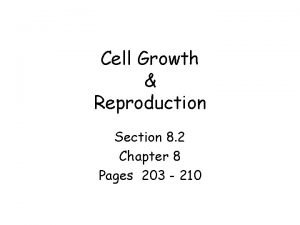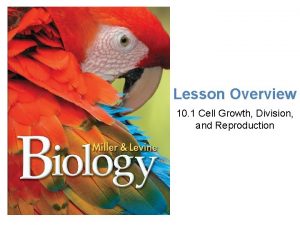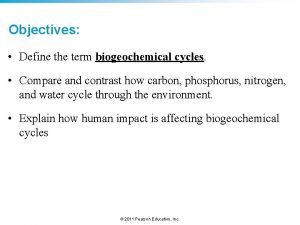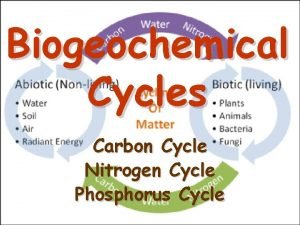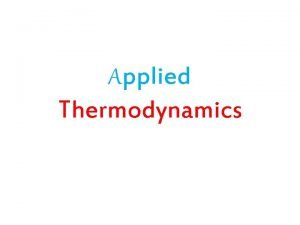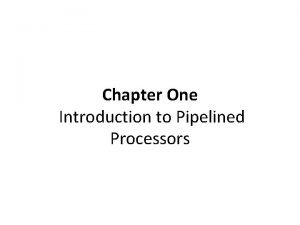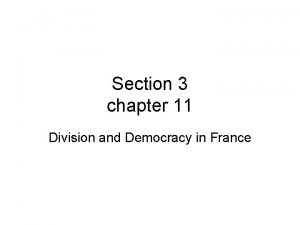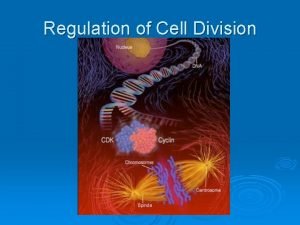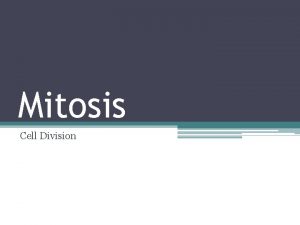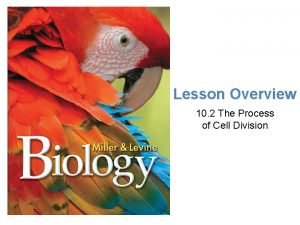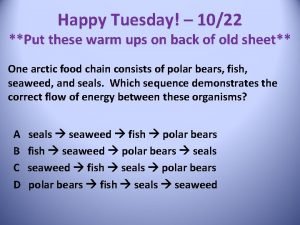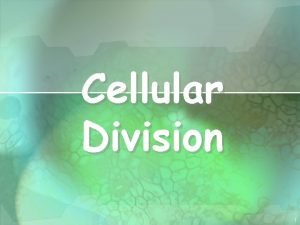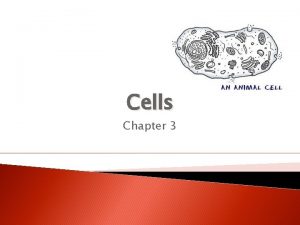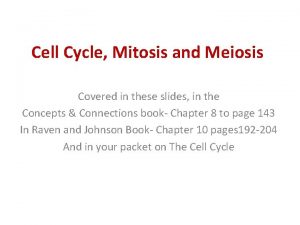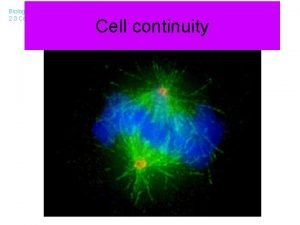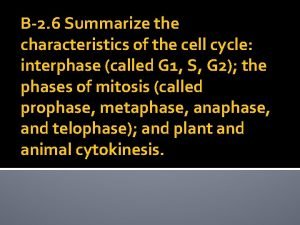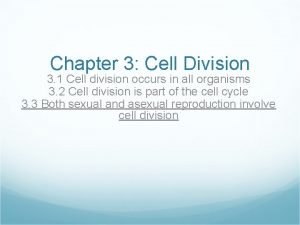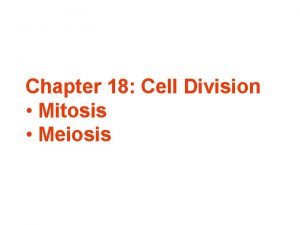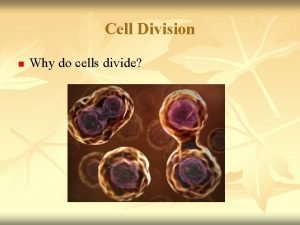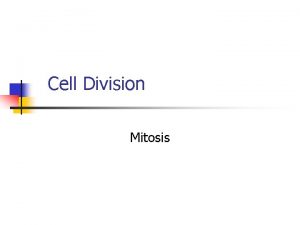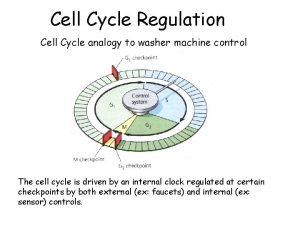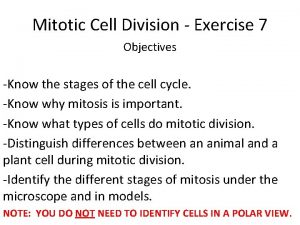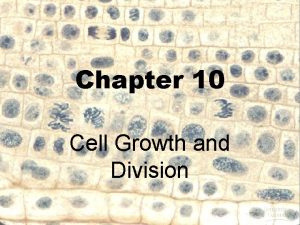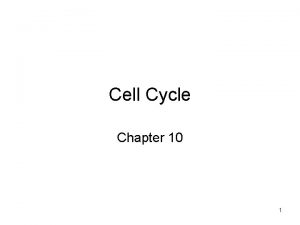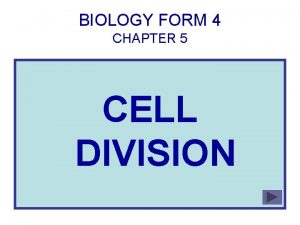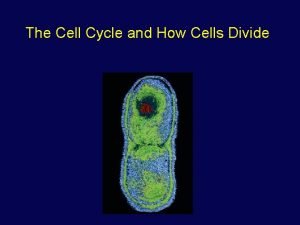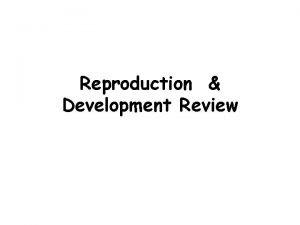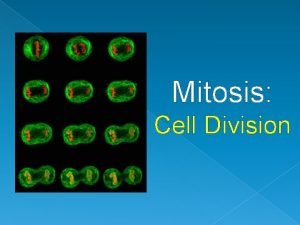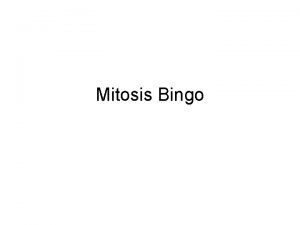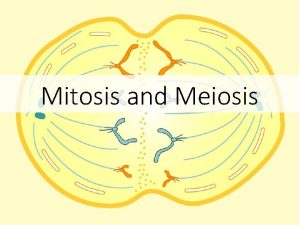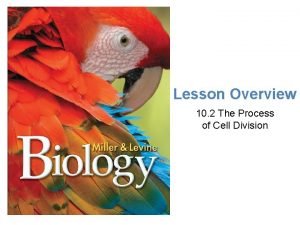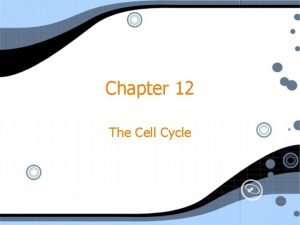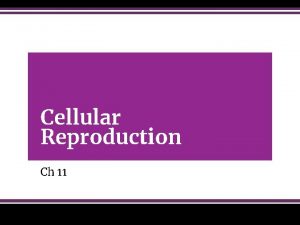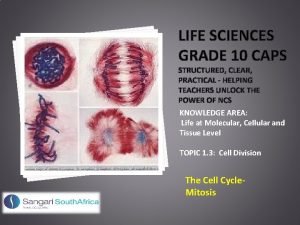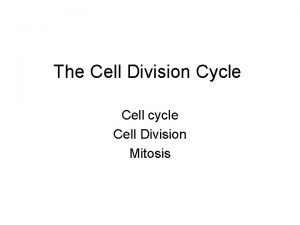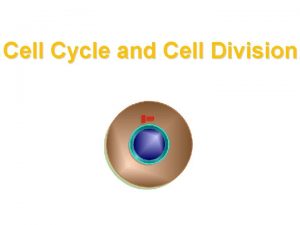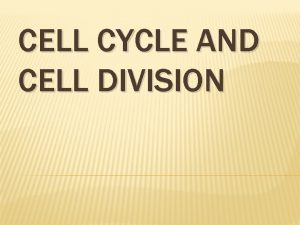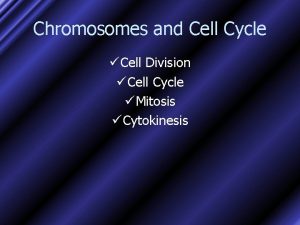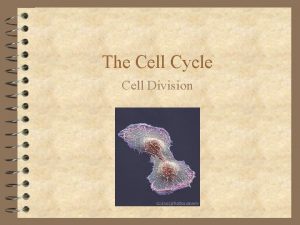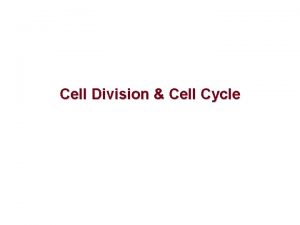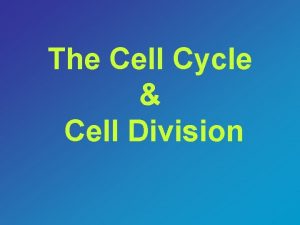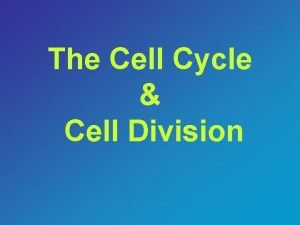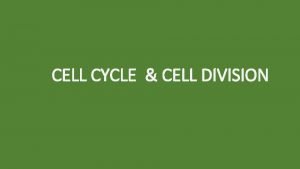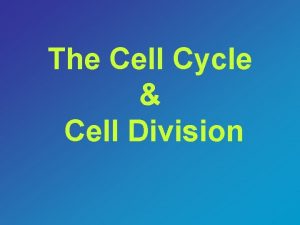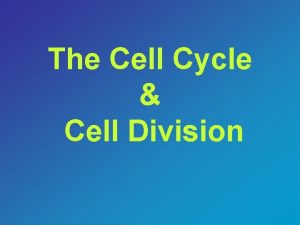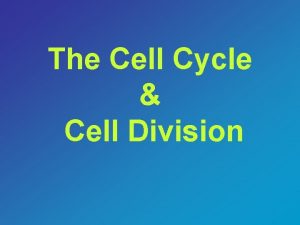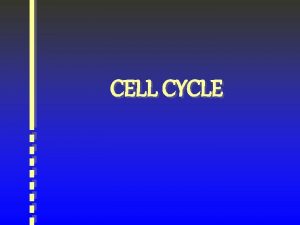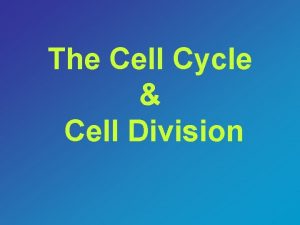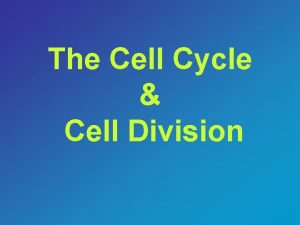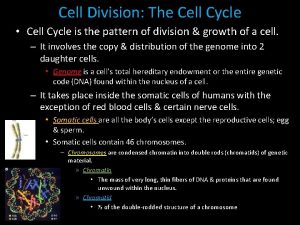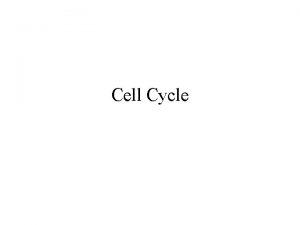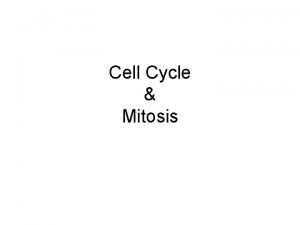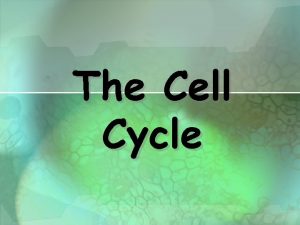CELL CHAPTER 10 CYCLE AND CELL DIVISION Cell
























































- Slides: 56

CELL CHAPTER: 10 CYCLE AND CELL DIVISION

Cell cycle: The sequence of events by which the cell duplicates its genome and synthesises the other constituents of the cell and eventually divide into two daughter cells is called cell cycle.

Cell cycle Interphase. II. M phase. I.

A typical eukaryotic cell divide once in approx every 24 hrs. Vary cell to cell e. g. yeast 90 minutes. Cells- adults mammals spend about 20 hours in inter-phase, 90% of the total time.


BASIC PROCESSES IN CELL REPRODUCTION Cell growth: Period of synthesis of and duplication of various components of cell. Cell division: Adult cell divide in to two daughter cells. INTERPHASE ----- Phases. G 1, S, G 2.

CELL CYCLE & CELL DIVISION. Interphase: (inter-between, ) Period between end of one cell division to the beginning of next cell division. • Resting phase, • Metabolically active phase • Biosynthesis or energy phase. • Prepare for next division phase 95% duration of cell cycle

Inter-phase G 1 or gap 1 --or , post mitotic or presynthetic or first growth phase. Synthesis of RNA Carbohydrates, lipid protein the cell grows double its original size organelles are produced No DNA replication Increasing the volume of the cytoplasm.

S –PHASE: q DNA replicate, chromatids joined at centromere (primary constriction). q Centrosome replication. q Synthesis of basic protein i. e Histone protein. q Chromosome number same.

G 2 (Gap 2): Cell resumes its growth. Synthesis of spindle protein. Types of RNA molecule. Synthesis of ATP & storage. Duplication of mitochondria & plastid. Damaged DNA is repaired.

G 0 (Gap zero), or an extended G 1 (Quiescent stage) G 0 as either an extended G 1 phase. When G 2 is completed the cell enters a relatively brief period of nuclear and cellular division, called mitosis and Cytokinesis respectively.

M PHASE OR MITOTIC PHASE: It involves separation of organelles, sister chromatids and their redistribution to daughter cells. Called equational division. Divided into four stages of nuclear division. Four different stages are prophase, metaphase, anaphase and telophase.

PROPHASE: During prophase the cell nucleus becomes spheroid. There is increase in the viscosity of cytoplasm. The chromosomes shorten and thicken and become stainable. By the end of prophase some chromosomes may contract up to 1/25 of their length in early prophase.


PROMETAPHASE: Disappearance of nuclear membrane. There is no differentiation between cytoplasm and Nucleoplasm due to disappearance of nuclear membrane. The chromosomes are attached to the spindle their centromeres.

METAPHASE: The chromosomes are usually lined up in one plane to form the equatorial plate or metaphase. Occasionally, only the centromere lies on the equatorial plane, while the chromosome arms directed away from the equator.


ANAPHASE: The chromosomes are arranged on the equatorial plate for a short period only. The centromeres of the chromosomes divide simultaneously as anaphase starts. The two chromatids of each pair separate. They are now called daughter chromosomes.




TELOPHASE: Restoration of Interphase condition. It is reverse of prophase. Two sets of daughter chromosomes reach opposite poles of the cell. Disappearance of spindle fibres. Formation of two daughter cells

CYTOKINESIS: In animals cell a cleavage furrow appears at the beginning of Telophase which becomes progressively deeper to form two daughter cells. In plant cell two daughter cells are formed due to cell plate formation.

SIGNIFICANCE Equal OF MITOSIS: distribution of chromosomes: It results in constant number of chromosomes. Repair: Repair of body takes place because of the addition of cells by mitosis. Opportunity for differentiation due to multicellular condition.

MEIOSIS: REDUCTIONAL DIVISION Occurs in germ cells to form gametes in sexually reproducing organisms. Many stages of meiosis are similar to mitosis. It includes meiosis I and meiosis II The essential stages during meiosis are: a) two successive divisions without any DNA replication occurring between them, b) formation of chiasmata and crossing over, c)segregation of homologous chromosomes, d) Separation of sister chromatids.

MEIOSIS: I Prophase -I DNA is exchanged between homologous chromosomes (crossover). The new combinations of alleles/GENES. The paired and replicated chromosomes are called bivalents or tetrads. Non-sister chromatids may cross-over at points called chiasmata (plural; singular chiasma.


Leptotene: Greek words "thin threads". Chromosomes begin to condense. Two sister chromatids are still so tightly bound indistinguishable.


Zygotene: The Zygotene or zygonema, means "paired threads. “ The synapsis (pairing/coming together) of homologous chromosomes takes place. Chromosome synapsis is followed by the formation of complex structure called synaptonemal complex. Pair of synapsed homologous chromosomes is called a bivalent or a tetrad.


Pachytene: thick threads Clear appearance of tetrad. Characterised by appearance of recombination nodules. Exchange takes place at sites where recombination nodules (the chiasmata) have formed. (Crossing over occurs between non- sister chromatids of homologous chromosomes. Enzyme recombinase is involved in crossing over.


Diplotene: § § Diplonema, or Diplotene means "two threads. “ Synaptonemal complex degrades. The chromosomes uncoil a bit. The homologous chromosomes remain tightly bound at X-shaped structure called chiasmata.


Diakinesis: Final stage of meiotic prophase I. Terminalisation of chiasmata. Condensation of chromosomes. Appearance of spindle fibres. By the end of this phase nucleolus and nuclear membrane disappears.


Metaphase I: The bivalents become arranged in the plane of the equator forming equatorial plate. The centromere of each chromosome is directed towards the opposite poles and the arms of chromosomes face the equatorial plate. The microtubule from the opposite poles of the spindle attach to the pair of homologous chromosomes.


Anaphase I: The homologous chromosomes separate, while sister chromatids remain associated at their centromeres. Thus each poles receives half the number of chromosomes or haploid set of the chromosomes.


Telophase I: The chromosomes arrive at the poles. Each daughter cell now has half the number of chromosomes. The microtubules that make up the spindle network disappear. The chromosomes uncoil back into chromatin. Cytokinesis take place to form two daughter cells. Cells may enter a period of rest known as interkinesis or Interphase II.



Meiosis II: Similar to mitosis. Production of four haploid cells The four main steps: Prophase II, Metaphase II, Anaphase II, and Telophase II.

Prophase II: Disappearance of the nucleoli and the nuclear envelope/ nuclear membrane Shortening and thickening of the chromatids. Centrioles move to the polar regions and arrange spindle fibers.


Metaphase II: The centromeres contain two kinetochores that attach to spindle fibers. The chromosomes align at the equator and the microtubules from opposite poles of the spindle get attached to the kinetochores of sister chromatids.


Anaphase II: The centromeres are cleaved, Fibre-kinetochores to pull the sister chromatids apart. The sister chromatids called sister chromosomes.


Telophase II: Uncoiling and lengthening of the chromosomes. Disappearance of the spindle. Reappearance of nucleolus and nuclear membrane. Cleavage or cell wall formation. Four daughter cells, with a haploid set of chromosomes.




SIGNIFICANE OF MEIOSIS: In helps in maintaining the definite and constant number of chromosomes in the organisms. Helps in increasing genetic variability. Helps in formation of gametes. It leads to evolution.
 Cell cycle and cell division
Cell cycle and cell division Cell cycle and cell division
Cell cycle and cell division Cell cycle and cell division
Cell cycle and cell division Section 8-2 cell division
Section 8-2 cell division Long division and short division
Long division and short division Long division worksheets
Long division worksheets How to synthetic divide
How to synthetic divide Synthetic division example
Synthetic division example Chapter 5 principles of engine operation
Chapter 5 principles of engine operation Biology.arizona.edu/cell bio/activities/cell cycle/01.html
Biology.arizona.edu/cell bio/activities/cell cycle/01.html The scientist mathias schleiden studied _______ in ______.
The scientist mathias schleiden studied _______ in ______. Cell division mitosis and meiosis
Cell division mitosis and meiosis Chromosome labeled
Chromosome labeled Meiosis
Meiosis Cell growth division and reproduction
Cell growth division and reproduction Phosphorus cycle pearson education
Phosphorus cycle pearson education Difference between phosphorus cycle and carbon cycle
Difference between phosphorus cycle and carbon cycle Difference between open cycle and closed cycle gas turbine
Difference between open cycle and closed cycle gas turbine Greedy cycle
Greedy cycle Disadvantages of mhd generator
Disadvantages of mhd generator Chapter 11 section 3 division and democracy in france
Chapter 11 section 3 division and democracy in france Cell division acronym
Cell division acronym Frequency of cell division
Frequency of cell division Does crossing over occur in both mitosis and meiosis
Does crossing over occur in both mitosis and meiosis Interphase of cell cycle
Interphase of cell cycle Metaphase of mitosis
Metaphase of mitosis Ipmatc acronym ideas
Ipmatc acronym ideas Telophase
Telophase Is a sticky semi fluid material found
Is a sticky semi fluid material found Sexual and asexual reproduction
Sexual and asexual reproduction Cell furrow method
Cell furrow method Spindle biology
Spindle biology Mitosis
Mitosis Prophase 1
Prophase 1 Venn diagram of sexual and asexual reproduction
Venn diagram of sexual and asexual reproduction Unicellular cell division
Unicellular cell division Aster cell division
Aster cell division Cell division
Cell division Cell division vocabulary
Cell division vocabulary Cell division analogy
Cell division analogy Prophase microscope
Prophase microscope Mitosis pipe cleaner activity
Mitosis pipe cleaner activity Section 10-1 cell growth
Section 10-1 cell growth Events of the cell cycle
Events of the cell cycle Mind map mitosis meiosis
Mind map mitosis meiosis Chromosome consists of
Chromosome consists of What process is this
What process is this Interphase
Interphase Cell division
Cell division Cell division phases
Cell division phases Mitosis cell division
Mitosis cell division Type of cell division
Type of cell division What happens during telophase?
What happens during telophase? What phase is this cell in
What phase is this cell in Cell division
Cell division Cell division
Cell division Uncontrolled cell division
Uncontrolled cell division



